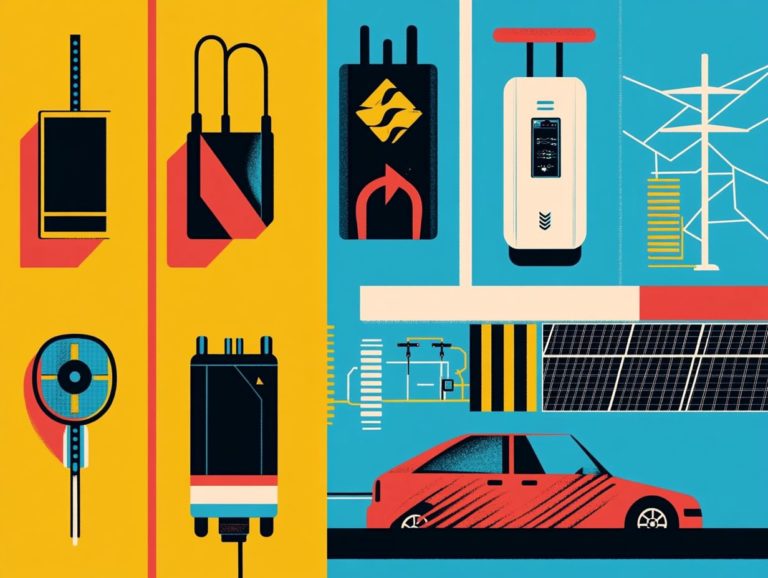How to Troubleshoot Common Energy Storage Issues
Energy storage plays a vital role in today s energy landscape, allowing you to harness and utilize power with remarkable efficiency.
However, challenges do arise. From battery failures to overcharging concerns, grasping these common issues is key to maintaining optimal performance.
This guide will empower you to quickly identify and solve energy storage problems!
Furthermore, you ll discover maintenance tips and alternative solutions that will keep your energy storage both reliable and efficient.
Contents
- Key Takeaways:
- Understanding the Importance of Energy Storage
- Common Energy Storage Problems
- Troubleshooting Techniques
- Maintaining Optimal Energy Storage
- Frequently Asked Questions
- What are common energy storage issues?
- How can I troubleshoot low battery life in my energy storage system?
- Why is my energy storage system charging slowly?
- What should I do if my energy storage system suddenly loses power?
- Why am I having trouble connecting my devices to the energy storage system?
- How can I prevent common energy storage issues from occurring?
Key Takeaways:

- Regular maintenance is crucial for optimal energy storage performance. Schedule routine check-ups to avoid battery failures.
- Identifying the root cause of problems is the first step in troubleshooting. Use diagnostic tools to pinpoint issues.
- Prevent overcharging by using proper techniques and monitoring charge levels. This can extend battery lifespan.
Understanding the Importance of Energy Storage
In today s energy landscape, grasping the significance of Battery Energy Storage Systems (BESS) is vital. BESS store energy for later use, making renewable sources more reliable, ensuring efficient energy output, and enhancing capacity utilization across a range of applications.
As you navigate the transition toward sustainable energy solutions, including technologies powered by Iron Phosphate Batteries and Sodium-Based Batteries, you ll find that energy storage is essential for maintaining grid stability and supporting Electric Vehicles.
Organizations like the Department of Energy and the University of Sydney are innovating to tackle BESS challenges, positioning energy storage as a pivotal component of our future.
Common Energy Storage Problems
Battery Energy Storage Systems have advanced greatly. However, they still face common challenges that can affect performance and efficiency.
These challenges encompass issues like Battery Management System (BMS) malfunctions, complications in calculating State of Charge (SOC), and cell imbalances, all of which can diminish energy output and capacity utilization.
Battery Failure
Battery failure poses a critical concern for Battery Energy Storage Systems, as it can lead to serious consequences, including thermal runaway and a notable decline in energy performance.
To effectively address this issue, it’s crucial to understand the root causes of such failures. Manufacturing defects, such as inconsistent material quality or subpar assembly practices, can make a battery less reliable, highlighting the challenges of implementing energy storage.
Environmental factors, including extreme temperatures, high humidity, or exposure to corrosive elements, can further accelerate degradation. Additionally, operational parameters like overcharging and prolonged cycling can intensify wear and tear.
These challenges carry significant implications for energy storage solutions, impacting both efficiency and safety. Implementing advanced Battery Management Systems (BMS) can mitigate these risks.
By continuously monitoring battery health, optimizing charge cycles, and regulating temperature, a BMS can enhance longevity and performance, ensuring that your energy storage remains reliable and effective.
Stay informed and take action now to maintain your energy storage systems. Your energy efficiency depends on it!
Insufficient Charge
Insufficient charge in Battery Energy Storage Systems can significantly impede energy output. This results in inefficiencies across various applications, including electric vehicles. This issue often arises from inaccurate State of Charge (SOC), which indicates the current energy level of the battery and may not accurately reflect its actual energy levels.
Factors such as temperature fluctuations, age-related capacity degradation, and inconsistent charging patterns complicate matters. These can hinder optimal functionality. Advanced Battery Management Systems can optimize your charging cycles. To learn more, check out 5 ways to optimize your home energy storage as they help you manage your battery more effectively.
These systems ensure that your battery is charged under ideal conditions. They facilitate precise SOC assessments and enhance overall charging performance, ensuring you have adequate energy available when needed.
Overcharging

Overcharging is a common challenge in battery management. It can impede capacity utilization and potentially harm Battery Energy Storage Systems.
This issue often arises from incorrect configurations of the Battery Management System (BMS) and user oversights, such as failing to follow specific charging protocols. Understanding energy storage and these contributing factors is essential for optimizing your battery’s performance.
Integrated safety measures within the BMS are crucial for monitoring charge levels and preventing overcharging. By employing advanced algorithms and real-time data, the BMS ensures that your battery operates within safe parameters. This ultimately extends its lifespan and enhances efficiency.
Understanding these dynamics empowers you to adopt better practices and significantly improve your battery’s health.
Troubleshooting Techniques
Troubleshooting techniques are crucial for diagnosing and resolving issues within Battery Energy Storage Systems. By employing these methods, you can ensure optimal battery performance and enhance longevity. This ultimately safeguards your investment and maximizes efficiency.
Identifying the Root Cause
Identifying the root cause of issues in Battery Energy Storage Systems is essential for effective troubleshooting and optimal battery performance.
To achieve this, use various techniques for symptom analysis, such as monitoring the State of Charge (SOC) alongside performance metrics that reflect the system’s overall health. Conducting regular visual assessments and technical tests is key; this proactive approach can catch potential problems before they escalate. For detailed guidance, refer to how to monitor your energy storage performance. It not only identifies issues that could impact efficiency but also extends the lifespan of your systems.
Utilizing structured testing procedures and leveraging advanced diagnostic tools gives you clearer insights into any irregularities. This enables you to take preventative measures that protect the functionality of your Battery Energy Storage System, ensuring peak condition.
Solving Battery Failure
Addressing battery failure requires a comprehensive strategy that tackles underlying BMS issues and potential risks, such as thermal runaway.
To manage these challenges effectively, consider both immediate corrective actions and proactive long-term strategies. Start by identifying specific indicators of failure, such as reduced performance or unusual swelling. Implement quick fixes like replacing faulty cells or ensuring that connections are secure. For a comprehensive approach, refer to 5 essential tips for maintaining energy storage units. However, these measures alone won’t suffice.
Establishing regular maintenance routines, including system checks and battery testing, is vital for prolonging battery life. Integrating advanced Battery Management Systems is also essential, as they monitor performance and prevent future failures by providing real-time data and diagnostics. For more information, consider understanding the maintenance needs of energy storage, which fosters an environment of reliability and safety.
Preventing Overcharging
Preventing overcharging in battery storage systems is vital. It optimizes capacity use and boosts the effectiveness of your energy storage.
This approach helps maintain battery longevity and efficiency. As a result, you ll enjoy reliable performance over time.
A well-tuned Battery Management System (BMS) is instrumental in this endeavor, as it incorporates the right settings to regulate charging cycles effectively.
It’s important to know best practices like not keeping batteries at full charge when not in use. By implementing advanced monitoring technologies, you can gain access to real-time data, enabling timely adjustments and interventions. This proactive approach helps mitigate the risks associated with overcharging, such as shortened battery lifespan and decreased power output. For more insights, check out this guide on how to prepare for an energy storage upgrade.
Maintaining Optimal Energy Storage

Maintaining optimal energy storage is crucial for the efficient operation of Battery Energy Storage Systems. It ensures that energy output aligns seamlessly with the demands of diverse applications and technologies.
Your attention to this aspect will significantly enhance performance and reliability.
Regular Maintenance and Upkeep
Regular maintenance and upkeep of Battery Energy Storage Systems are essential for sustaining battery performance and maximizing capacity utilization over time.
You should incorporate periodic inspections to spot any signs of wear or deterioration. Complement this with comprehensive testing procedures that evaluate the health of your batteries.
Staying ahead with software updates is crucial, ensuring your system operates with the latest enhancements and security protocols. If you neglect these maintenance tasks, your battery efficiency will drop quickly!
By prioritizing regular evaluations and timely interventions, you can prevent costly replacements and guarantee optimal performance.
Once your existing system is well-maintained, consider exploring alternative energy solutions.
Alternative Energy Storage Solutions
Exploring alternative energy storage solutions like Gravity-Based Systems, Sodium-Based Batteries, and Thermal Energy Storage offers exciting new options for boosting your energy efficiency and sustainability!
These innovative technologies stand in stark contrast to traditional Battery Energy Storage Systems (BESS), each offering distinct advantages that tackle specific challenges. For example, Gravity-Based Systems harness kinetic energy in an environmentally friendly manner, making them promising candidates for large-scale applications. It’s also crucial to understand how to ensure your energy storage system is safe to maximize their benefits.
Sodium-Based Batteries, in comparison, offer a more sustainable and potentially lower-cost alternative to lithium-ion batteries. Meanwhile, thermal energy storage can effectively balance supply and demand, although it may not yet rival the instantaneous response times of traditional BESS. For those curious about energy storage, here are 5 frequently asked questions about energy storage.
Understanding their performance metrics will be vital for you in determining how effectively these solutions can integrate into renewable energy grids and contribute to a greener future.
Frequently Asked Questions
What are common energy storage issues?
Common energy storage issues include low battery life, slow charging, sudden power loss, and difficulty connecting to devices.
How can I troubleshoot low battery life in my energy storage system?

To fix low battery life, check for apps draining energy. Also, adjust settings to save power and ensure the battery is connected properly.
Why is my energy storage system charging slowly?
Slow charging can be caused by various factors such as using a low-quality charger, a damaged battery, or a faulty charging port. Try using a different charger or have the battery and charging port checked by a professional.
What should I do if my energy storage system suddenly loses power?
Is your energy storage system suddenly down? Start by checking the battery level and charge.
If the battery is fully charged, try resetting the system or looking for updates that improve how it works.
If the problem continues, contact the manufacturer right away for quick help!
Why am I having trouble connecting my devices to the energy storage system?
Are you struggling to connect your devices? Ensure the system is powered on and within range.
Also, check that your device works with the energy storage system. If the issue persists, restart both the system and your device.
How can I prevent common energy storage issues from occurring?
To avoid common energy storage problems, regularly maintain and update the system.
Use high-quality chargers and batteries, and steer clear of overcharging. Always follow the manufacturer’s guidelines and tackle any issues as soon as they come up.






